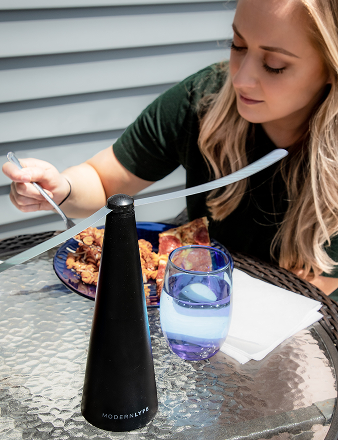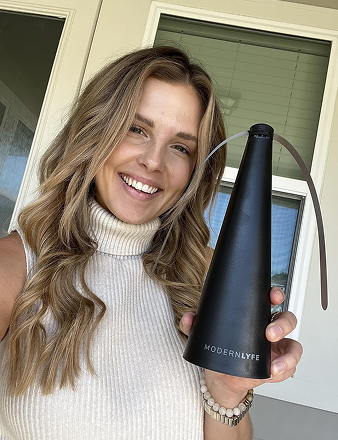Yes, an outdoor fan for mosquitoes is an effective, chemical-free way to reclaim your patio. It works for two reasons: the airflow is too strong for their weak wings, and it disperses the carbon dioxide (CO2) you exhale—the gas they use to find you. This simple strategy creates a powerful, localized barrier against bites.
How Fans Create a Mosquito-Free Zone
An outdoor fan creates a mosquito-free zone using simple physics. It establishes an invisible shield that turns your favorite outdoor spot into a no-fly zone for pests by exploiting two of their biggest weaknesses: weak flight and a CO2-based hunting method. Understanding how a fan disrupts both makes it clear why this is a go-to solution for enjoying the outdoors in peace.
Overpowering Weak Fliers
What feels like a pleasant breeze to you is a hurricane to a mosquito. These insects are weak fliers. Weighing only a few milligrams, their wings are designed for navigating still air, not fighting a steady current.
A fan producing a wind speed of just 5-7 MPH is enough to ground them. When a mosquito tries to fly into this moving air, it gets tossed around, unable to stabilize or reach its target.
Think of it like trying to row a toy boat across a fast stream; the current is too strong. The fan's airflow creates a physical barrier that mosquitoes cannot cross.
The Key Takeaway: An outdoor fan creates an environment where a mosquito's own biology makes it physically impossible to fly, land, or bite.
Creating an Invisibility Cloak
Even more important than grounding them is how a fan disrupts their tracking system. Mosquitoes don't hunt by sight; they hunt by "smell." They can detect the carbon dioxide (CO2) you exhale from over 100 feet away.
They follow this invisible trail of gas directly to its source. If you can eliminate that CO2 trail, you become effectively invisible to them.
An outdoor fan for mosquitoes acts as a cloaking device.
To put it simply, a fan's airflow creates a bug-free barrier in two primary ways:
| Disruption Method | How It Protects You |
|---|---|
| Physical Force | The constant breeze is stronger than a mosquito's flight, physically preventing them from getting close enough to land and bite. |
| Sensory Jamming | The airflow disperses the CO2 you exhale, effectively hiding your "scent" and making you invisible to their tracking system. |
By combining these two effects, the fan turns your personal space into a protected zone.
The fan accomplishes this sensory jamming by:
- Dispersing CO2 Plumes: The airflow scatters the CO2 you exhale, so there's no concentrated trail to follow.
- Confusing Their Senses: Instead of a clear path, the fan creates a chaotic mix of air, making it impossible to pinpoint your location.
- Masking Other Attractants: The breeze also dissipates other attractants, like your body heat and sweat.
By breaking up these signals, the fan makes you disappear from their radar. Mosquitoes in your yard may sense a meal is nearby but can't find it, forcing them to look for an easier target.
The Science of Why Mosquitoes Hate Wind
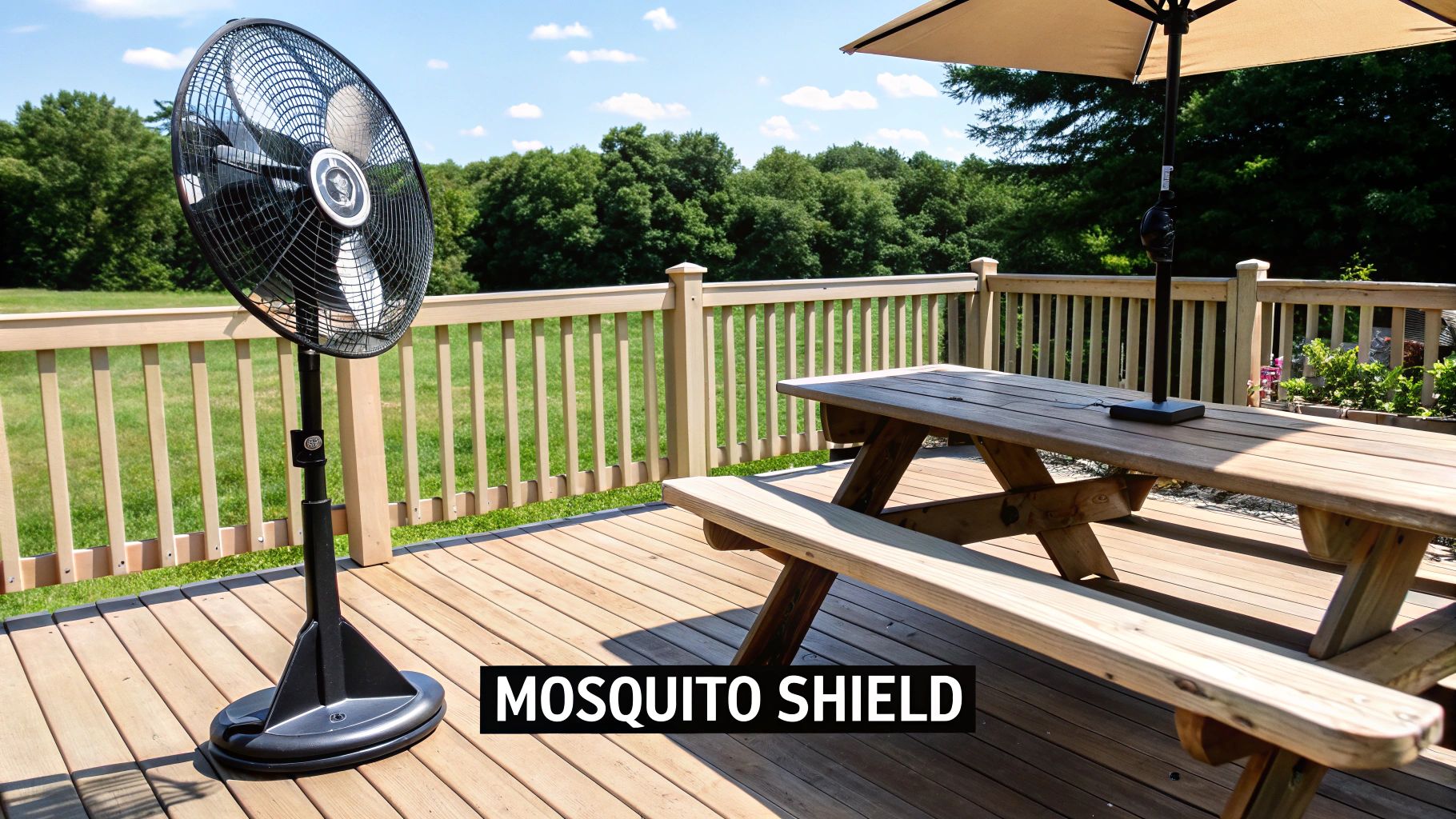
To understand why an outdoor fan for mosquitoes is so effective, you need to understand the insect's biology. Their entire design is optimized for calm, still air. A simple fan turns their strengths into weaknesses, creating a powerful, bite-proof shield for your patio.
We'll examine two of their biggest vulnerabilities: their lightweight bodies and their reliance on chemical trails to hunt. Once you see how a fan systematically dismantles both, you'll understand why it's such a reliable solution.
Their Flight Is No Match for Airflow
First, mosquitoes are incredibly fragile. Weighing a mere 2.5 milligrams, their bodies are built for stealth, not for fighting the elements. This feather-light design is an advantage in quiet air but becomes a massive liability as soon as the wind picks up.
To a mosquito, a gentle breeze from a fan feels like a hurricane. Their tiny bodies and large wings can't handle it. The moment they fly into moving air, they lose all control—they're tossed around, unable to fly straight or stay airborne.
This isn't a minor inconvenience; it's a total flight system failure. Research shows that mosquitoes can't fly effectively in winds of even a few miles per hour. The average outdoor fan easily creates an environment that's physically impossible for them to navigate, stopping them long before they get near you.
Scrambling Their Navigation System
Disrupting their flight is one thing, but a fan’s real power is making you invisible. Mosquitoes don’t find you with their eyes. They are sophisticated scent-trackers that use specialized receptors to lock onto the plume of carbon dioxide (CO2) you exhale.
You are constantly leaving an invisible CO2 trail in the air. Mosquitoes can detect this trail from over 100 feet away and follow it with stunning precision right back to you. CO2 is their primary homing beacon.
An outdoor fan essentially jams their guidance system.
By constantly moving and mixing the air, a fan dilutes and disperses the carbon dioxide you exhale. This action effectively erases the scent trail mosquitoes rely on, making you invisible to their senses.
The fan creates a bubble of chaotic air where your CO2 signature is scattered into untraceable wisps. The mosquito might know someone is in the area, but it has no clear path to follow. Frustrated and confused, they move on to find an easier meal. You can find more details about how fans keep various bugs away in our dedicated article.
This one-two punch—physically overpowering them while making you invisible—is what makes a fan so effective. It’s not just a repellent; it's a tool that creates a micro-environment where a mosquito's biology fails it. By turning their weaknesses against them, you can carve out a comfortable, bite-free zone without zappers or chemicals.
Choosing the Right Outdoor Mosquito Fan
Choosing the right outdoor fan to keep mosquitoes away is about more than just aesthetics. To create a bug-free bubble on your patio, you must match the fan’s power and features to your space. Get it right, and you'll get maximum protection without blowing your napkins away.
Homeowners are increasingly choosing chemical-free ways to enjoy their backyards. The U.S. market for mosquito repellents, including fans, was valued at USD 1.47 billion in 2023 and is projected to hit USD 2.41 billion by 2032. This growth shows a major shift toward physical deterrents like fans.
Decoding Fan Power with CFM
The most important metric for an outdoor fan is its CFM, or Cubic Feet per Minute. This measures how much air it moves in one minute. The higher the CFM, the stronger the breeze and the larger your protected zone.
Matching the CFM to your space is critical. A low-CFM fan won't be effective on a large deck, while an industrial fan is overkill for a small balcony.
Here's a quick guide:
- Small Balconies (under 150 sq. ft.): Look for a fan in the 800 to 1,500 CFM range. This provides enough power to create a gentle, consistent airflow.
- Standard Patios (150-300 sq. ft.): The sweet spot is 1,500 to 3,000 CFM. This gives you solid coverage for a typical outdoor dining or seating area.
- Large Decks (over 300 sq. ft.): For bigger spaces, you’ll need a fan with a CFM of 3,000+. You might even consider using two smaller fans to create overlapping zones of protection.
Comparing Different Outdoor Fan Types
The style of fan you choose dictates its coverage, placement, and appearance. Each type offers different advantages.
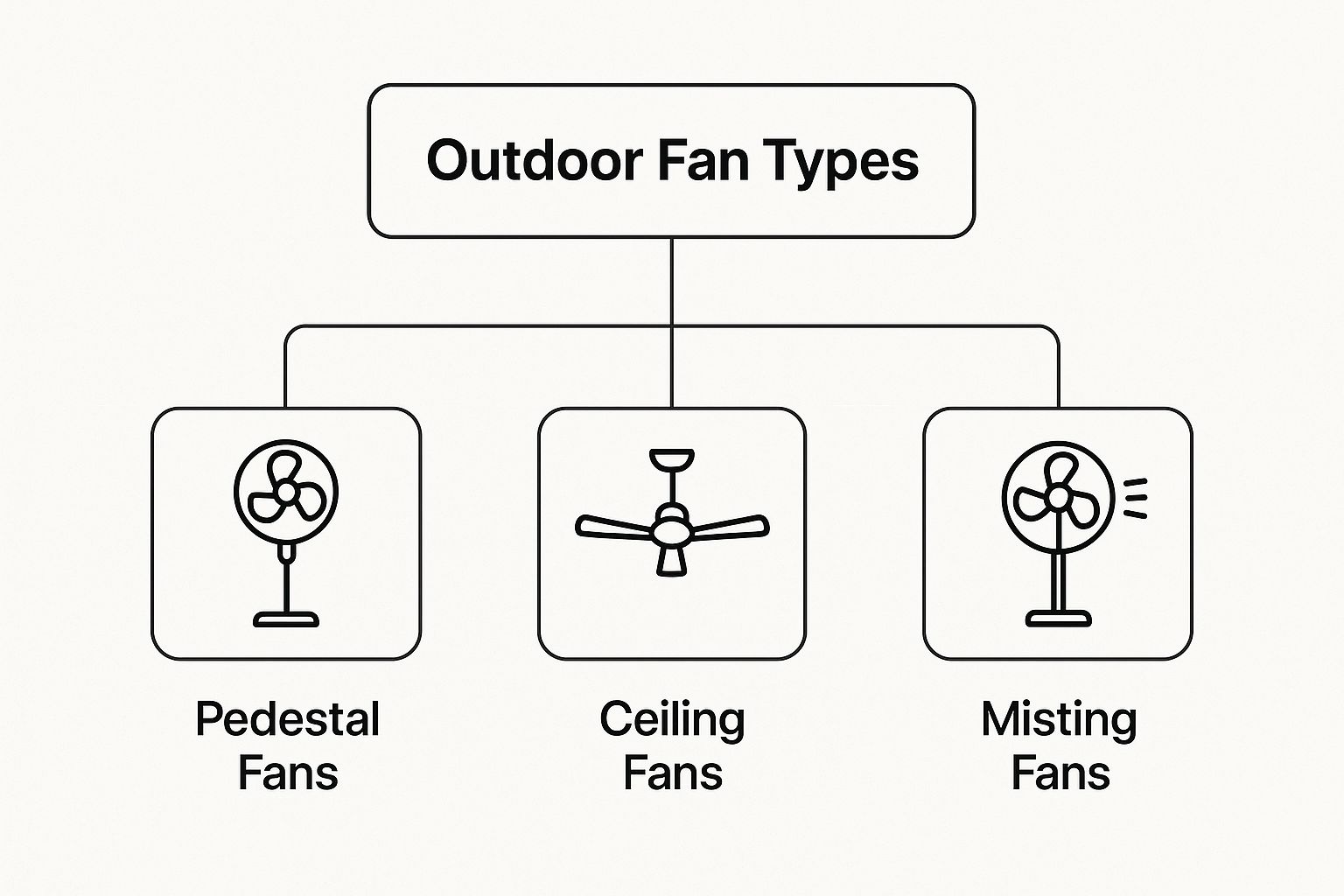
Let's break down each type.
- Pedestal Fans: These are the workhorses of outdoor fans. They're portable, height-adjustable, and most oscillate to cover a wide area. Their main drawback is they take up floor space and require an outlet.
- Wall-Mounted Fans: If you're short on floor space, a wall-mounted fan is a great solution. It delivers a powerful, targeted breeze from above, keeping it out of the way. The trade-off is that it requires installation and is not portable.
- Ceiling Fans: For a covered patio or pergola, an outdoor-rated ceiling fan is a permanent, stylish choice. They provide excellent air circulation over a large, predictable area. Ensure it is specifically rated for outdoor use to handle humidity.
- Misting Fans: These fans combine a cooling breeze with a fine mist of water. They are ideal for hot days, but be careful that the mist doesn't create puddles, which could attract more mosquitoes.
The best fan is the one that fits your space and lifestyle. A portable pedestal fan offers flexibility, while a permanent ceiling fan provides seamless, integrated protection for a covered deck.
Must-Have Features for Durability and Performance
Beyond CFM and fan type, a few key features distinguish a true outdoor fan from an indoor model. These are non-negotiable for longevity and performance.
First, check for a weather resistance rating, typically an IP (Ingress Protection) rating. Look for an IP rating where the second number is 4 or higher (e.g., IPX4). This means the fan can withstand water splashes from any direction, making it safe for damp conditions.
Next is oscillation. A fan that pivots back and forth covers more ground than a stationary one, which is essential for protecting multiple people.
Finally, consider the noise level. The goal is a peaceful, bug-free space, not an airport runway. Look for models known for quiet motors or multiple speed settings so you can adjust the power and sound. You can explore our guide on the best outdoor fans for mosquitoes for top picks that balance power and quiet operation.
Strategic Fan Placement for Maximum Protection
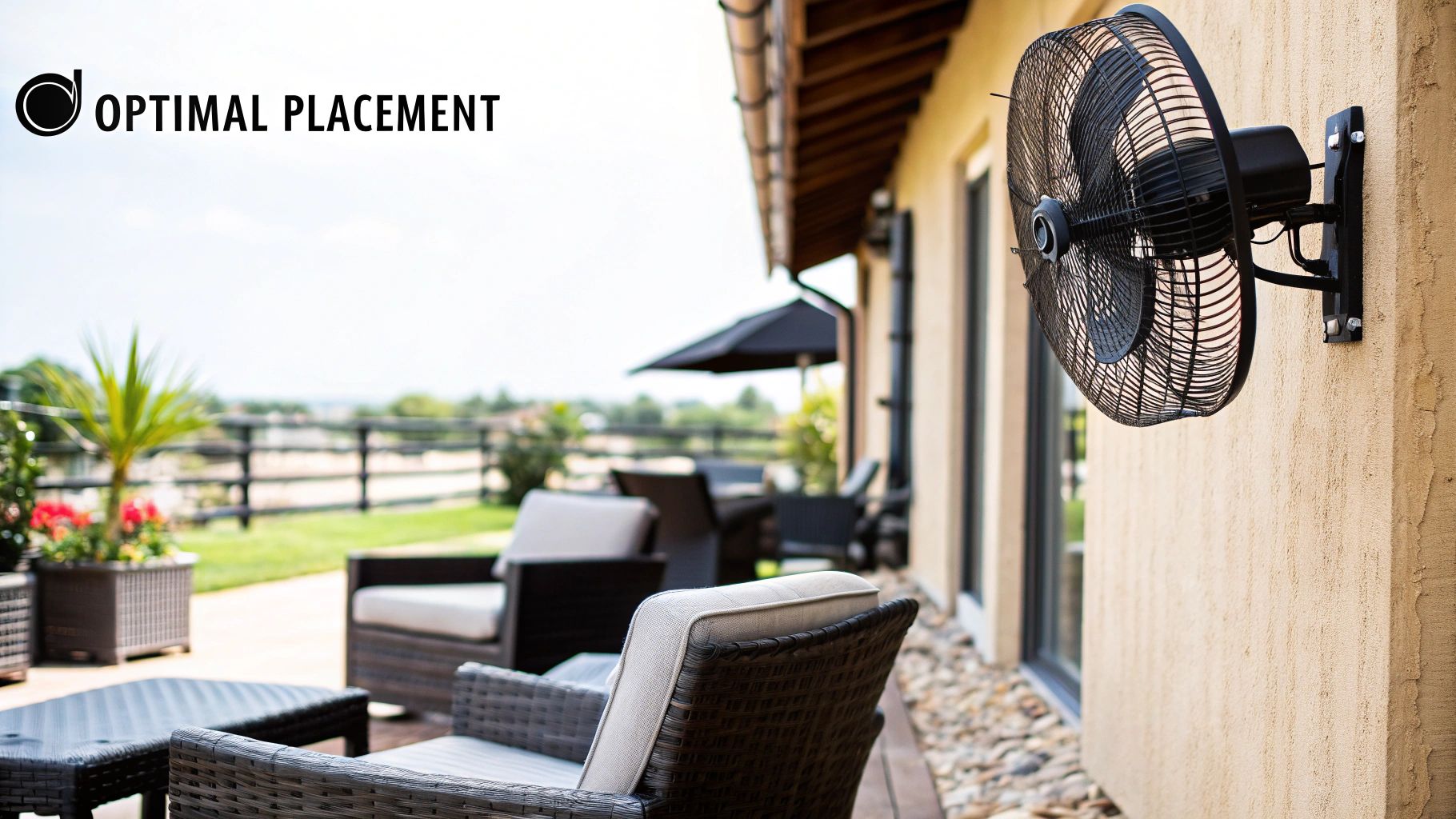
Even the most powerful fan is ineffective if placed incorrectly. Where you position your outdoor fan for mosquitoes is as important as the fan itself. The goal is to build an intentional, invisible "wind wall" that shields your outdoor living space from pests.
Think of it as setting up a defensive perimeter. You want the airflow positioned between you and where mosquitoes originate—usually lawns, gardens, or damp, shaded areas. This creates a buffer that physically blocks their flight path and scatters your scent (CO2) before they can lock onto it. Proper placement turns a simple fan into a targeted mosquito-fighting machine.
Creating the Wind Wall Effect
The core strategy is to create a consistent "wind wall." This is a steady, horizontal airflow moving across the edge of your seating area, acting as a physical barrier that weak-flying mosquitoes can't penetrate.
To achieve this, place your fan on the perimeter of your patio, aiming it across your seating area—not directly at it. You want a sweeping breeze that protects everyone without being a nuisance. The ideal feeling is a gentle, consistent airflow, not a direct blast.
For a standard patio, follow these steps:
- Identify Your Zone: Determine the main seating or dining area you want to protect.
- Position the Fan: Place a pedestal or floor fan at one corner of this zone, just outside of it.
- Aim Across, Not At: Angle the fan so the air blows horizontally across the front of your seating area.
- Use Oscillation: If available, use the oscillation feature to create a wide, sweeping wall of air covering the entire perimeter.
This setup ensures any mosquito attempting to enter the area is immediately hit by a current it cannot overcome.
Your goal is to create a protective barrier around your space. Position the fan to blow air across the edges of your patio, effectively sealing off the main entry points for mosquitoes.
Advanced Strategies for Different Layouts
Not all outdoor spaces are simple squares. A covered porch requires a different approach than an open deck. Adjust your strategy to fit your layout for better results.
For Covered Patios or Pergolas
An outdoor-rated ceiling fan is perfect here. It creates a steady downward column of air that pushes mosquitoes away from the center. For enhanced protection, add a smaller floor fan at a corner to block bugs that fly in low from the side.
For Large or L-Shaped Decks
A single fan will struggle to cover a large or oddly shaped area. The solution is to use multiple fans to create overlapping zones of protection. Place one fan at each end of the space, angled to create a cross-breeze. This ensures there are no "dead air" spots for mosquitoes to sneak through.
Fine-Tuning Your Fan Setup
Once your fan is in place, you may need to make minor adjustments. The outdoor environment changes, and your fan setup should be adaptable.
- Consider Prevailing Winds: Pay attention to the natural breeze direction. Position your fan to work with the wind, not against it, to amplify its effect and extend its reach.
- Adjust Fan Height: Fan height matters. For pedestal fans, adjust the height so the airflow targets the lower half of your body (from the knees down). Mosquitoes often fly low to the ground to avoid wind, and this targets them where they are most active.
By taking a few minutes to think strategically about placement, you can ensure your fan is working efficiently to keep you comfortable and bite-free.
Integrated Mosquito Control for Your Yard
An outdoor fan is an excellent tool against mosquitoes, acting as both a physical barrier and a sensory jammer. However, to create a truly bite-free yard, the fan should be part of a larger strategy. When you combine your fan with other mosquito control methods, you build a layered defense that protects your deck while reducing the mosquito population across your entire yard.
This broader strategy makes your property fundamentally less hospitable to pests. Your fan provides frontline defense for immediate relief, while other tactics work in the background to reduce their numbers. This approach means your yard remains a less inviting place for mosquitoes even when the fan is off.
Creating Synergy with Other Devices
Your fan's airflow can boost the effectiveness of other mosquito control devices. This allows you to build a system where each part enhances the others, with the fan acting as an amplifier.
A great example is pairing a fan with a bug zapper. Many modern zappers include their own fans to improve their catch rate, proving this combination works. The market for these devices reflects this; in 2024, the global mosquito zapper market was valued at USD 450 million and is expected to hit USD 700 million by 2033. This surge shows a clear demand for effective, non-chemical mosquito solutions.
Here’s how to create a dynamic duo:
- Place the zapper downwind from your fan and away from your seating area.
- The fan's breeze will carry the CO2 and other attractants from the zapper over a wider area, luring mosquitoes toward it.
- Simultaneously, the fan carves out a "safe zone" for you, creating a protected bubble while the zapper establishes a "danger zone" for pests.
Eliminating Mosquito Breeding Grounds
The most effective long-term mosquito control method is to eliminate their breeding grounds. Mosquitoes need stagnant water to lay eggs, and they don't need much—a bottle cap of rainwater is sufficient. Removing these nurseries is the only way to stop the problem at its source.
While your fan handles adult mosquitoes, eliminating standing water prevents the next generation from ever taking flight.
A single female mosquito can lay up to 100 eggs at a time, which can hatch in as little as 24-48 hours. By dumping out standing water, you're stopping hundreds or even thousands of future mosquitoes before they have a chance to bite you.
Once a week, walk around your property and check for these common trouble spots:
- Clogged gutters and drains
- Water in flowerpot saucers or buckets
- Birdbaths (change the water every few days)
- Kiddie pools, toys, or tarps left in the rain
- Old tires or other debris that can hold water
This simple habit is a cornerstone of any pest management plan. To learn more about creating a comprehensive strategy, it's worth understanding principles like Integrated Pest Management (IPM).
Making Your Yard Naturally Uninviting
Finally, you can adjust your landscaping to make your yard less appealing to mosquitoes. During the day, mosquitoes seek cool, shady, and damp places to rest. A well-kept yard offers fewer hiding spots. You can also explore our article covering the OFF! Bug Control Fan, which discusses various ways to combine fans with other repellents.
Keep your lawn mowed and trim back overgrown bushes, especially in shady areas. This allows more sunlight and air to circulate, creating a drier environment that mosquitoes dislike.
You can also use nature to your advantage by planting natural pest repellents. These plants release scents that mosquitoes avoid, adding another passive layer of protection.
Plants That Naturally Deter Mosquitoes:
- Citronella Grass: Its strong, citrusy aroma is a well-known mosquito repellent.
- Lavender: Beautiful and pleasant-smelling to humans, but mosquitoes dislike it.
- Marigolds: These flowers contain pyrethrum, a compound found in many commercial insect repellents.
- Rosemary and Basil: These herbs are great for cooking and also help keep mosquitoes away.
By combining a powerful outdoor fan for mosquitoes with smart yard care and strategic use of other devices, you can create a comprehensive defense that makes your backyard a place you can truly enjoy.
Common Questions About Outdoor Mosquito Fans
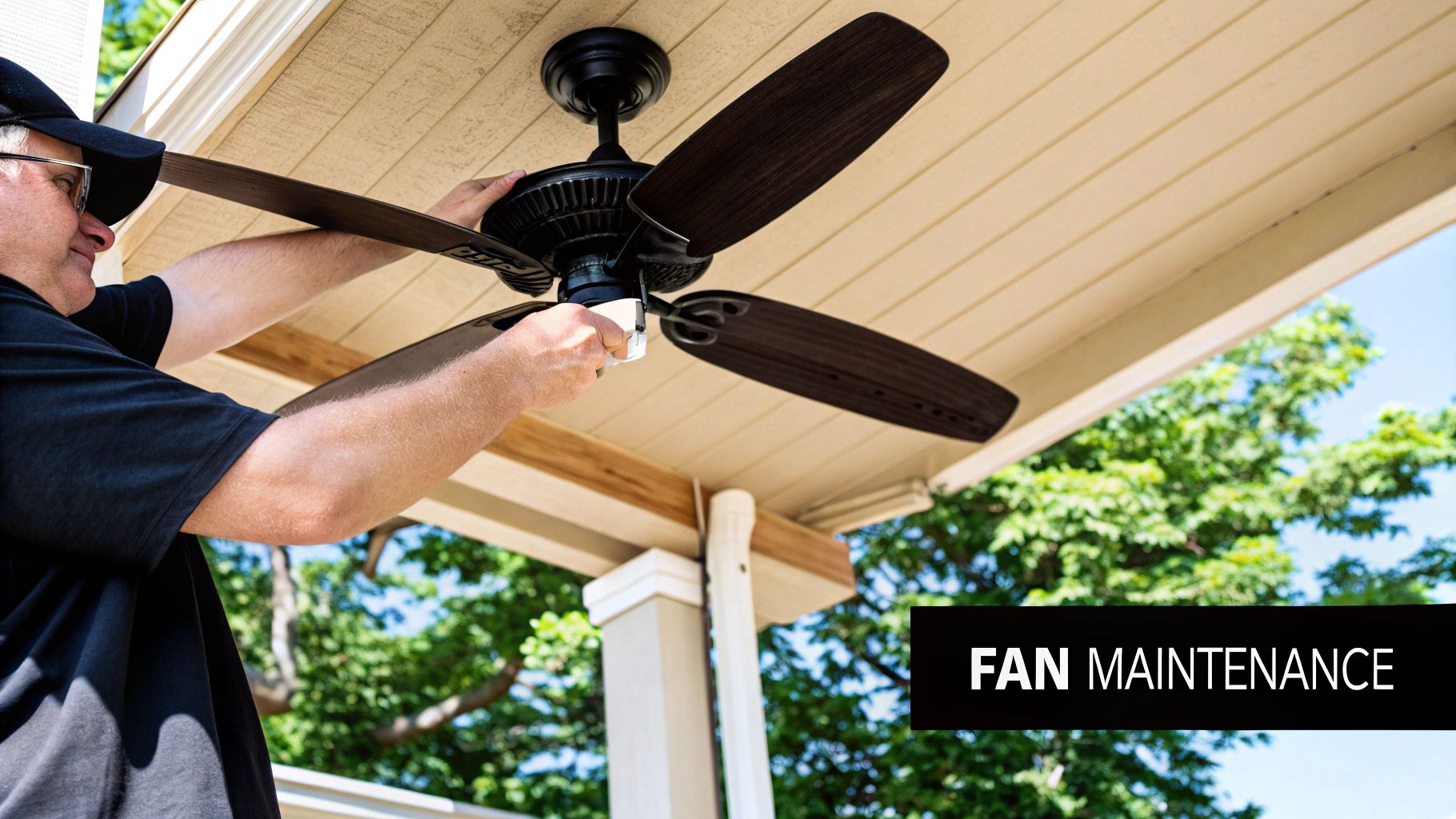
Even after understanding how an outdoor fan for mosquitoes works, practical questions often arise. It's one thing to know the theory but another to choose the right fan for your yard.
Getting these details right is what separates a truly bug-free space from just a windy patio. Here are answers to some of the most common questions.
How Strong Does My Fan Need to Be?
A fan's power is measured in CFM (Cubic Feet per Minute)—how much air it moves. For most backyard patios, a fan rated between 1,000 and 2,000 CFM is ideal.
This creates a gentle but persistent breeze (around 5-7 MPH) that is strong enough to stop a mosquito but won't blow away your napkins. For very large areas, use multiple fans to create overlapping "no-fly zones" rather than a single, high-powered one.
Will a Fan Work on Other Bugs Besides Mosquitoes?
Yes. The same airflow that grounds mosquitoes works just as well on other weak fliers like gnats and black flies.
Think of it as an invisible screen. The breeze also helps dissipate aromas from food and drinks, which attract various flying pests. While it won't stop a determined wasp, it makes your space far less inviting for most common airborne nuisances.
A fan's effectiveness isn't limited to one type of pest. It creates a physical barrier that works against any insect too weak to fly against a steady current, making it a versatile tool for general bug control.
Are Misting Fans More Effective for Mosquitoes?
Misting fans cool you down while blowing bugs away. On a hot day, the cooling mist is a huge plus and can make the area less appealing to heat-seeking pests.
However, for mosquito control alone, a standard high-CFM fan is just as effective. The main caution with misting fans is to avoid creating puddles of standing water, which can become mosquito breeding grounds. If you want to beat the heat and the bugs, a mister is a great choice, but for pure bug-repelling power, a regular fan is perfectly sufficient.
What Is the Most Energy-Efficient Type of Fan?
Fans with DC (Direct Current) motors are the most energy-efficient. This newer technology can use up to 70% less energy than traditional AC (Alternating Current) motors.
That difference adds up on your utility bill, especially if you run the fan frequently. DC motor fans may have a higher upfront cost but pay for themselves over time. For a guaranteed efficient choice, look for the ENERGY STAR® logo, which certifies that the fan meets strict efficiency standards.
Ready to create your own bite-free zone? The fans from MODERN LYFE offer the perfect blend of style and power to keep your outdoor gatherings comfortable and pest-free. Discover the ideal solution for your space at https://modernlyfe.com.


